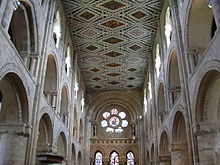Waltham Abbey Church

The Abbey Church of Waltham Holy Cross has been a place of worship since at least 1030, and is in the town of Waltham Abbey, Essex, England. The Prime Meridian passes through its grounds. Harold Godwinson is said to be buried just outside the present abbey.
History
Waltham Abbey was founded in 1030 to house a Holy Rood or Cross that was the subject of pilgrimage[1]. Legend says that at Montacute near Glastonbury, an Anglo-Danish Thegn called Tovi the Proud found a large black flint crucifix buried at the top of a hill, following a dream. He loaded the cross onto an ox-cart, but the oxen would only go in one direction and didn't stop until they reached Waltham, a journey of some 150 miles[2]. Harold Godwinson (later King Harold II) rebuilt, refounded and richly endowed the church in 1060; a legend says that this was because in his childhood, he had been miraculously cured of paralysis by the Holy Cross[3]. He stopped to pray at Waltham on his way to fight William of Normandy, and the battle-cry of the English troops at Hastings was "Holy Cross". After the battle, William's corpse is said to have been brought back to the abbey and buried there.[4] Harold's work was demolished and a new church was built in the Norman style in about 1120[5]. In 1177, Henry II again refounded the Abbey, this time as an Augustinian foundation, as part of his penance for the murder of Thomas Becket. At this point extensive additional building works were carried out, although the nature and extent of these still await detailed research. The rebuilding, in the Early English style, made the abbey far more extensive than the original Norman establishment, as can be seen today from traces in the abbey grounds.
The Augustinian abbey was a popular place for overnight stays with kings and other notables who were hunting in Waltham Forest. It was the last abbey in England to be dissolved, in 1540. Thomas Tallis was the last organist at the Abbey prior to its dissolution. The Holy Cross disappeared without trace at this time. Henry VIII suggested Waltham as one of the new cathedrals for the Church of England, but the proposal was not implemented. The Abbey site was leased to Sir Edward Denny and the remnant of the nave became the town's parish church[6].
Description

All of the eastern parts of the Abbey were demolished at the Dissolution, as was the original Norman crossing. The present-day church consists of the nave of the Norman abbey church, the 14th-century Lady Chapel and west wall, and a 16th century tower, added after the Dissolution. Markers on the remains of the walls in the grounds indicate the location, before demolition, of the high altar (beneath which some believe Harold Godwinson is buried)[7], and other parts.
The interior is notable for the massive Norman piers and also for the many carvings of human faces nestling in the stonework left by the original masons. Waltham Abbey is also renowned for its 15th-century Doom (painting).
Recent architectural history

In 1859, the architect William Burges was appointed to undertake a restoration of the site and a refurbishment of the interior. The restoration was extensive; the removal of pews and galleries from the South and West, the creation of a new ceiling (showing signs of the zodiac as at Peterborough Cathedral), significant re-building and the creation of a new chancel. The designs were exhibited at the Royal Academy. Work was complete by 1876.
The Abbey's stained glass is particularly noteworthy, including early work by Edward Burne-Jones in the rose window and lancets of the east wall, and A K Nicholson in the Lady Chapel. Much was destroyed during The Blitz.
In the view of Burges's biographer, J. Mordaunt Crook, "(Burges's interior) meets the Middle Ages as an equal." However the architectural historian Nikolaus Pevsner states that Burges's remodelling was carried out "with all the robust ugliness which that architect liked"[8]. The revised Pevsner of 2007 takes a somewhat more sympathetic view, describing Burges' work as "pioneering (and) powerful" [9].
Links with Harold Godwinson
Harold's links with the area, (although only his connection with the original foundation can be proven) persist. The local secondary school, King Harold School, is named after the last Saxon King of England.
Organ
The church contains a large 3 manual organ, mostly by J. W. Walker & Sons Ltd. A specification of the organ can be found on the National Pipe Organ Register.
Organists
Its organists have included:
- Thomas Tallis
- Polly Thompson
- William Hayman Cummings 1847 - 1853
- Mr. Gibbons
- Mr. Banks
- Joseph Chalk 1859 - ????
- Stuart Nicholson
- Stephen Bullamore 2005 - current
External links
- Church site
- English Heritage
- Adrian Fletcher's Paradoxplace – Waltham Abbey Page
- Waltham Abbey Reflections Of the Past
- Waltham Abbey Genealogy site
- Waltham Abbey Historical Society
- Map sources for Waltham Abbey Church.
- [1]
Notes
- ^ http://www.britannia.com/church/waltham.html
- ^ The Waltham Chronicle, Leslie Watkiss & Marjorie Chibnall, Oxford University Press, 1994
- ^ http://www.channel4.com/history/microsites/H/history/e-h/harold04.html
- ^ http://www.walthamabbeychurch.co.uk/history.htm
- ^ http://www.walthamabbeychurch.co.uk/history.htm
- ^ http://www.channel4.com/history/microsites/H/history/e-h/harold04.html
- ^ Butler, Denis: 1066: The Story of a Year, 1966, p. 292
- ^ The Buildings of England: Essex (1965)
- ^ The Buildings of England: Essex: (Revised 2007) pages 807-809
References
- J. Mordaunt Crook, William Burges and the High Victorian Dream (1981) John Murray
- Nikolaus Pevsner, The Buildings of England: Essex Penguin, 1965 ISBN 0140710116
- Nikolas Pevsner and James Bentley, The Buildings of England: Essex, Yale University Press, 2007 ISBN 9780300116144
